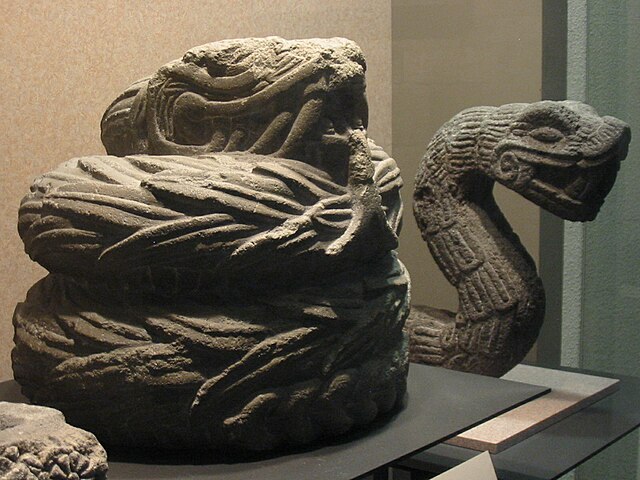Meaning of K’uk’ulkan
- K’uk’ulkan is a Yucatec Maya word that translates directly to “Feathered Serpent” in English.
- It represents a powerful deity in Maya mythology, often associated with wisdom, creation, and the cycles of life, death, and rebirth.
The name itself encapsulates the duality of this important figure:
- “K’uk'”: This part refers to the feathers, symbolizing connection to the divine, air, and knowledge.
- “Ulkan”: Meaning “serpent,” this aspect represents primordial power, transformation, and cyclical renewal.

The Feathered Serpent
Divine Deity in Mayan Mythology
K’uk’ulkan, also known as the Feathered Serpent, holds a prominent position in Mayan mythology as a multifaceted deity associated with creation, wisdom, knowledge, rain, wind, and fertility.
The name K’uk’ulkan is derived from the Mayan language and translates to “Shining Serpent” or “Feathered Serpent.” The term “K’uk'” refers to the shining, brilliant quality often attributed to feathers, while “Ulkan” signifies serpent.
K’uk’ulkan was worshipped across the Maya civilization, with particular veneration at the major city of Chichen Itza. There, a grand temple dedicated to him, known as El Castillo, stands as a testament to his significance.
Origin and History
Pre-Classic Period (2000 BCE – 250 CE)
Evidence suggests that K’uk’ulkan emerged as a deity during the Pre-Classic period, possibly originating from earlier Mesoamerican cultures.
Classic Period (250 CE – 900 CE)
During the Classic period, K’uk’ulkan gained prominence throughout the Maya world, becoming one of the most revered deities.
Post-Classic Period (900 CE – 1697 CE)
The worship of K’uk’ulkan continued into the Post-Classic period, with his influence persisting even after the decline of major Mayan cities.
Meaning and Attributes
- Creation: K’uk’ulkan was often associated with creation myths, playing a role in shaping the world and bringing order to chaos.
- Wisdom and Knowledge: The Feathered Serpent was considered a wise and knowledgeable deity, embodying the mysteries of the cosmos and the secrets of life.
- Rain and Fertility: K’uk’ulkan was also linked to rain, wind, and fertility. He was believed to control the cycles of nature, bringing sustenance and abundance to the land.
- Protection: K’uk’ulkan was revered as a protective deity, safeguarding people and communities from harm.
K’uk’ulkan’s enduring legacy in Mayan mythology continues to fascinate scholars and enthusiasts alike. His multifaceted nature, embodying both destructive and creative forces, reflects the complexities of the ancient Maya worldview.
Origin and Etymology
K’uk’ulkan, also known as the Feathered Serpent, is a powerful deity in Mesoamerican mythology, particularly prominent in Mayan and Yucatecan traditions.
The name K’uk’ulkan originates from the Yucatec Maya language. “K’uk'” means “feathers,” while “ulkan” signifies “serpent.” Therefore, its literal translation is “Feathered Serpent.”
This deity represents a complex and multifaceted figure associated with creation, wisdom, knowledge, war, and the cyclical nature of life and death. K’uk’ulkan is often depicted as a feathered serpent with human features, sometimes wearing a headdress adorned with serpents or feathers.
The most famous representation of K’uk’ulkan is found at Chichen Itza, where the Temple of Kukulkan stands as a testament to this deity’s importance. The temple’s architecture cleverly aligns with astronomical events, demonstrating the deep connection between K’uk’ulkan and celestial phenomena.
Various Mesoamerican cultures worshipped deities with similar attributes, suggesting a broader syncretic tradition that connected the Feathered Serpent archetype across regions. While interpretations may differ, K’uk’ulkan consistently embodies themes of renewal, transformation, and divine power within these cultural contexts.
Ancient Maya Roots Deconstructing the Name History and Significance
Kukulkan in Different Regions Temple Construction and Astronomical Alignments
Kukulkan, a prominent deity in Maya mythology, embodies both wisdom and power, often associated with serpents, quetzal birds, wind, and rain. The name Kukulkan itself holds deep cultural significance, reflecting the complex beliefs and cosmologies of the Maya civilization.
The word “Kukulkan” is composed of two Mayan words: “K’u,” meaning “snake,” and “ulkan,” meaning “wind.” This linguistic origin reveals a fundamental aspect of the deity’s nature: his embodiment of both earthly forces (serpents) and celestial energies (wind).
While Kukulkan was venerated throughout the Maya region, his cult reached particular prominence in the Yucatan Peninsula during the Late Classic period (600-900 CE), with major centers at Chichen Itza and Uxmal.
Chichen Itza’s iconic El Castillo pyramid serves as a testament to Kukulkan’s astronomical significance. Its carefully aligned steps cast serpent-like shadows that appear during the spring and autumn equinoxes, mimicking the deity’s descent to earth. This celestial spectacle symbolizes Kukulkan’s association with cyclical renewal and cosmic order.
At Uxmal, the intricate carvings of the Governor’s Palace depict Kukulkan in feathered serpent form, surrounded by scenes of Mayan cosmology. These artistic expressions highlight the complex interplay between earthly realms and the heavens, reinforcing the deity’s role as a mediator between these two spheres.
- Best Dun & Bradstreet (DNB) Alternatives for 2025 - April 26, 2025
- Best Seamless.ai Alternatives for 2025 - April 26, 2025
- Best Leadfeeder Alternatives for 2025 - April 25, 2025

